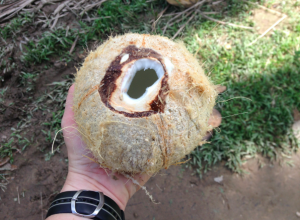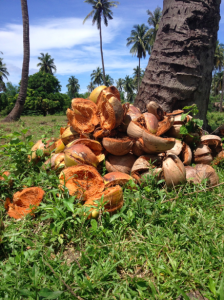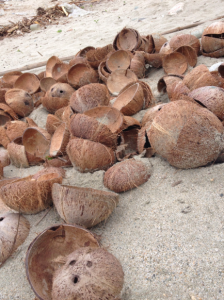I’ve been away from Australia for quite a while, sixty-six months to be precise. While we came home at least once a year between 2008 and 2015 (and lived in Brisbane for a year between our two postings in China), I’ve discovered quite a cultural knowledge gap since repatriating this year. Take coconut water, for example. I feel I’ve missed the point. I’m not seeing the value. I just don’t get it!
What on earth is coconut water? And when did it become an essential food group?
Going coconuts!

About to sample fresh coconut water during a hike through a plantation on the island of Mindoro, Philippines. Photo: Sonia Cahill
I’ve holidayed among coconut palms in developing countries and watched agile youngsters scamper up trunks, machete in hand, to hack a bunch of green coconuts from the palm. I’ve watched them peel back the husk and bore a hole into the centre, to drink directly from the fruit.
And I’ve gnawed fresh white flesh from the innards of said coconut – there’s simply no better way to enjoy the fruit (so much better than the desiccated variety found on supermarket shelves).
Deciphering coconut water, milk and cream?
Before this post, I thought the fluid inside a coconut was called ‘coconut milk’, an ingredient widely used in south-east Asian cooking – and an essential ingredient in Penang Chicken, one of our family’s favourite mid-week dinners. Somehow or other, ‘coconut cream’ is also produced (I assume that the ‘cream’ thicker part of the milk??).
But it seems I was completely misled. To answer my own question, it seems the fluid from the young, green coconut is indeed coconut water, while coconut milk is a manufactured product, made from gratings of coconut ‘meat’ – which I much prefer to call ‘flesh’ – of a brown coconut. The ‘meat’ is soaked in water, then the ‘milk’ is harvested by squeezing the moisture through cheesecloth. The difference between coconut ‘milk’ and ‘cream’ is how much water is added afterwards. Disclaimer: this is an oversimplified explanation…I’d love to learn more.
I’ve also read mixed reports about the nutritional value of this super food while conducting today’s research. Did you know coconut water is sterile and can be used intravenously as a hydration fluid in place of saline? While this is not recommended by medics, it was apparently common practice in Cambodia during the late 1970s, when the country was subjected to the horrors of the Khmer Rouge regime. That’s a story for another day.
As a latecomer to the trend (and despite my enlightening research for this post), coconut water sounds like a watered down version of the more well-established tinned variety (coconut milk), repackaged into fancy tetra paks and sold for a pretty profit.
Please dear friend, enlighten me: why do you buy coconut water? Does it live up to the hype? Is it just a passing phase? And how do you like to consume it?

